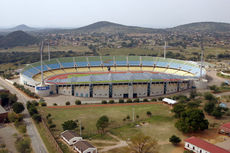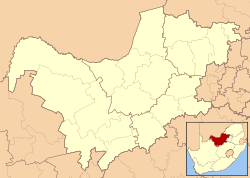Rustenburg
| Rustenburg | |
|---|---|
 |
|
 Rustenburg
|
|
| Coordinates: | |
| Country | South Africa |
| Province | North West |
| District municipality | Bojanala Platinum |
| Local municipality | Rustenburg |
| Elevation | 1,170 m (3,839 ft) |
| Population (2001) | |
| - Total | 395,539 |
| Time zone | SAST (UTC+2) |
| Website | Rustenburg Local Municipality |
Rustenburg (English: /ˈrʊstənbɜrɡ/, Afrikaans: [ˈrœstənbœrχ], Afrikaans and Dutch: Town of Rest) is a city of 395,539 inhabitants (2001 National Census) situated in at the foot of the Magaliesberg mountain range in North West Province of South Africa. It is one of the official host cities of the 2010 FIFA World Cup, being in close proximity to Phokeng, capital of the Royal Bafokeng Nation, where the Royal Bafokeng Stadium is located. The England national football team also used this as their base camp for the tournament.
Contents |
History
Rustenburg is prominent in Afrikaner history. The town was established in 1851 as an administrative centre for a fertile farming area producing citrus fruit, tobacco, peanuts, sunflower seeds, maize, wheat and cattle. On 10 February 1859, the local Dutch Reformed Church community was established. One of the oldest Boer settlements in the north, Rustenburg was the home of Paul Kruger, president of the South African Republic, who bought a 5 square kilometer farm to the north-west of the town in 1863. The homestead on his farm, Boekenhoutfontein, is now the Paul Kruger Country Museum. When the Boer and the British came to blows in the Second Boer War (1899), the territory around Rustenburg became a battlefield. The two sides clashed famously at nearby Mafikeng, where the British garrison found itself under siege for months. These battle sites can be explored from Rustenburg.
Among the first residents of Rustenburg were settlers of Indian origin. One of the first families of Indian origin was the Bhyat family, whose contribution to the city's history was marked by the renaming of a major streetname to Fatima Bhayat Street in honour of Fatima Bhyat who arrived in Rustenburg with her husband in 1877.
Rustenburg's population is primarily Batswana. Many belong to the Royal Bafokeng Nation, extensive landowners earning royalties from mining operations. The Royal Bafokeng also own the stadium selected as a World Cup 2010 venue.
Climate
Rustenburg has a temperate climate (Köppen Cwa), although it may be defined subtropical by some sources. It has hot summers (from December to February) and mild winters (from June to August). Precipitations occur mainly in summer.
| Climate data for Rustenburg | |||||||||||||
|---|---|---|---|---|---|---|---|---|---|---|---|---|---|
| Month | Jan | Feb | Mar | Apr | May | Jun | Jul | Aug | Sep | Oct | Nov | Dec | Year |
| Source: Rustenburg Local Municipality[1] | |||||||||||||
Platinum Hub
Rustenburg acts as a service centre for the many industries here. These include the agricultural communities surrounding the town, the platinum mining industry and the local manufacturing and product distribution industries.
Due to the mainly dry climatic conditions, agricultural activity consists of the farming of livestock (cattle and game) and small stock (poultry for egg production). There is also large-scale cultivation of citrus and irrigated crops such as tobacco and wheat, flowers and many plant nurseries.
Most of the mining activity in the region is centred around platinum on the Merensky Reef which stretches from west of the Pilanesberg Game Reserve towards Marikana and Brits in the east. The two largest platinum mines in the world are to be found here, and the area also produces asbestos, tin, chrome, lead, marble, granite and slate.
Tourist Hub
The city is located on major highway routes and close to 2 major centres, making it a hub for tourist activities. Within the city are some historic churches, including the Anglican Church (1871) and the Dutch Reformed Church (1898–1903), the historic statue of the Voortrekker girl and the Rustenburg Museum.
Communities and Battlefields
There are a multitude of sites with cultural and historical significance in and around Rustenburg. This is no surprise, given the many different communities in the area, such as the indigenous Bafokeng, Bakgatla and Botswana tribes, whose totemic tribal traditions are of much interest. There is also the German community of Kroondal that traces its origins back to 1857.
Many Anglo-Boer and ethnic war battles took place in the area with the districts of Koster, Swartruggens and Rustenburg featuring prominent battlefields, memorial graves and ruined forts. The area also has archaeological remains from the Iron Age and Stone Age.
Game Parks
By far the best known attractions in this area are the major nature reserves that are all within striking distance of Rustenburg itself.
- Kgaswane Game Reserve is situated above the town of Rustenburg across a varied habitat of quartzite mountain peaks, it is open to hikers as well as vehicle visitors. It is a 4 257 ha reserve that offers a great range of viewing experiences to wildlife enthusiasts.
- Madikwe Game Reserve and Groot Marico Park are huge reserves north of the Pilanesberg, almost half the size of Belgium. They are conservation and transition zone between the Kalahari sandveld and the thornveld. Madikwe hosts all the major plains species, including the Big Five and has the second largest concentration of elephants in South Africa. The reserve is one of South Africa's great natural treasures.
- Pilanesberg Game Reserve is one of the most accessible South African game reserves. It is located a 1.5 hour drive from Johannesburg and Pretoria and right outside Rustenburg. It is the fourth largest National Park in South Africa and is set high in the Pilanesberg range, traversing the floor of an ancient, long-extinct volcano. Pilanesberg conserves all the major mammal species including lion, leopard, elephant, rhino and buffalo.
Holiday Resorts
Sun City and Lost City, located beyond the Pilanesberg Game Reserve, are resorts where visitors can lose themselves in the luxury of an imagined world, with all the modern entertainments one can ask for. The complex is set on the slopes of a picturesque valley in the Pilanesberg Mountains and captures the essence of an ancient African kingdom. Casinos, the Valley of the Waves and two world-renowned championship golf courses are just some of the many attractions.
Sport
- Rustenburg is one of the host cities of the 2010 FIFA World Cup with the 42 000 seat Royal Bafokeng Stadium[1].
- Professional Football Clubs: Platinum Stars
- Rustenburg is home to another world-class stadium, Olimpia Park. It hosted some of the 1995 IRB World Cup games.
- The city is a regular venue for numerous sport-clubs incl. Kaizer Chiefs, Platinum Leopards, Springboks, Platinum Stars and various high profile athletics meets.
- A local school, Die Hoërskool Rustenburg is also the school with the most provincial athletes of any school in South Africa
- Rustenburg SkyDiving Club - a popular skydiving facility for sports skydiving and parachuting, tandem skydiving, Accelerated Freefall (AFF) and static line courses.[2][3]
Development
- Rustenburg is also reported to be the fastest growing city in South Africa [2].
- Rustenburg is home to the two largest platinum mines in the world and the world's largest platinum refinery, PMR [3] (Precious Metal Refiners), which processes around 70% of the world's platinum.
- As a result of the mining activity in the area, there is also an increased focus on social development. Rustenburg is one of only 5 South African cities to have a community foundation, called the Greater Rustenburg Community Foundation (GRCF), that seeks to ensure the regional development reaches all levels of society.
Rustenburg Airfeid
Rustenburg Airfield (FARG) is the Rustenburg Local Municipality Airfield, licensed according to Civil Aviation Authority standards[4]. Rustenburg SkyDiving Club operates every weekend year round from the airfield. [5]
Famous people
Famous people with roots in Rustenburg include:
- Rory Alec - Christian broadcaster
- Johan Botha - Opera singer
- Pik Botha - Politician and foreign minister (1977–1990)
- John Cranko - Ballet choreographer
- Koos du Plessis - Singer-songwriter
- Frik du Preez - Rugby union player
- Esta TerBlanche - Actress
- Andre Stander - Bank robber
- Bettie Celliers-Barnard - Painter
External links
References
- ↑ "Rustenburg State of Environment". http://www.rustenburg.gov.za/uploads/Environment%20Website/SOE.htm. Retrieved 2010-06-13.
- ↑ SkyDive Rustenburg, SkyDive Rustenburg website link retrieved 14th March 2010
- ↑ Parachute Association of South Africa
- ↑ South African Civil Aviation Authority, CAA website link retrieved 14th March 2010
- ↑ SkyDive Rustenburg, SkyDive Rustenburg website link retrieved 25th June 2010
|
|||||||||||